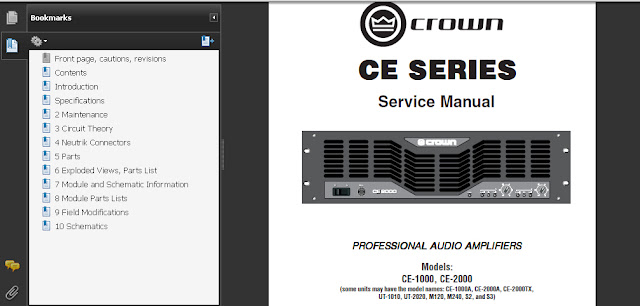The information furnished in this Crown CE-1000 Service Manual does not include all of the details of design, production, or variations of the equipment. Nor does it cover every possible situation which may arise during installation, operation or maintenance. If you need special assistance beyond the scope of this manual, please contact the Crown Technical Support Group. This manual contains service information for the Crown CE-Series power amplifiers. It is designed to be used in conjunction with the CE-Series Reference Manual. Some important information is, however, duplicated in this Service Manual in case the Reference Manual is not readily available.
This Crown CE-1000 Service Manual contains service information for the Crown CE-Series power amplifiers. It is designed to be used in conjunction with the CE-Series Reference Manual. Some important information is, however, duplicated in this Service Manual in case the Reference Manual is not readily available. The CE-Series amplifiers are compact, audio power amplifiers designed for professional use. These units provide high-power amplification from 20 Hz-20 kHz with minimum distortion. Features of these amplifiers are both Balanced Neutrik Combo (1/4-inch and XLR) and Barrier Block Inputs, Signal, Clip and Fault indicators, stereo or bridged-mono capability, switchable sensitivity, and Neutrik Speakon© Outputs. These units also feature a proportional speed fan, which optimizes cooling efficiency.
Crown specifications are guaranteed for three years. Further, we guarantee that every Crown amplifier will meet or exceed its published specs. An on/off rocker switch; also, a detented rotary level control for each channel. A two-position input sensitivity switch located below the input connectors. Can be set to 1.4 V for full output into an 8-ohm load, or set to a fixed voltage gain of 26 dB; Some models have an internal jumper located on the Main PWA for setting optional 0.775V sensitivity. A two-position mode switch located below the input connectors. When turned to stereo, the amplifier operates as two independent channels. When in “bridge-mono” mode the amplifier bridges the two output channels for twice the output voltage.
Fundamentally, troubleshooting involves looking for an abnormal situation. When a problem has been observed, it is obvious that something is not doing what it is expected to do. A single part, solder joint, or trace is usually the root cause, and testing for typical voltages and signal tracing can usually result in a solution for most of the problem units. Unfortunately, there are two other scenarios. (1) Sometimes a single problem may cause other parts to fail so there will be several parts that must be replaced. In this case, however, finding the root cause is not as important as just finding all of the blown or damaged parts and replacing them. The failed part will probably (but not always) be among them and the act of replacing the parts will fix the amplifier. (2) If the observed behavior is an oscillation, high THD, or the output slammed to one of the rails, the very nature of a feedback amplifier will spread this effect throughout the power amplifier section. This troubleshooting guide and a familiarity with amplifier operation should help you fix whatever comes your way!.
Download Crown CE-1000 Service Manual here
This Crown CE-1000 Service Manual contains service information for the Crown CE-Series power amplifiers. It is designed to be used in conjunction with the CE-Series Reference Manual. Some important information is, however, duplicated in this Service Manual in case the Reference Manual is not readily available. The CE-Series amplifiers are compact, audio power amplifiers designed for professional use. These units provide high-power amplification from 20 Hz-20 kHz with minimum distortion. Features of these amplifiers are both Balanced Neutrik Combo (1/4-inch and XLR) and Barrier Block Inputs, Signal, Clip and Fault indicators, stereo or bridged-mono capability, switchable sensitivity, and Neutrik Speakon© Outputs. These units also feature a proportional speed fan, which optimizes cooling efficiency.
Crown specifications are guaranteed for three years. Further, we guarantee that every Crown amplifier will meet or exceed its published specs. An on/off rocker switch; also, a detented rotary level control for each channel. A two-position input sensitivity switch located below the input connectors. Can be set to 1.4 V for full output into an 8-ohm load, or set to a fixed voltage gain of 26 dB; Some models have an internal jumper located on the Main PWA for setting optional 0.775V sensitivity. A two-position mode switch located below the input connectors. When turned to stereo, the amplifier operates as two independent channels. When in “bridge-mono” mode the amplifier bridges the two output channels for twice the output voltage.
Fundamentally, troubleshooting involves looking for an abnormal situation. When a problem has been observed, it is obvious that something is not doing what it is expected to do. A single part, solder joint, or trace is usually the root cause, and testing for typical voltages and signal tracing can usually result in a solution for most of the problem units. Unfortunately, there are two other scenarios. (1) Sometimes a single problem may cause other parts to fail so there will be several parts that must be replaced. In this case, however, finding the root cause is not as important as just finding all of the blown or damaged parts and replacing them. The failed part will probably (but not always) be among them and the act of replacing the parts will fix the amplifier. (2) If the observed behavior is an oscillation, high THD, or the output slammed to one of the rails, the very nature of a feedback amplifier will spread this effect throughout the power amplifier section. This troubleshooting guide and a familiarity with amplifier operation should help you fix whatever comes your way!.
Download Crown CE-1000 Service Manual here

0 Response to "Crown CE-1000 Service Manual"
Post a Comment